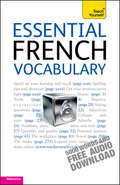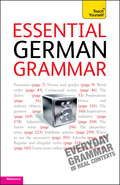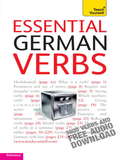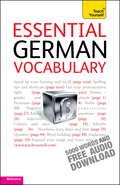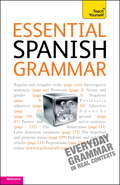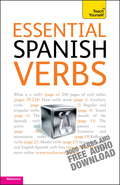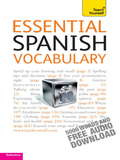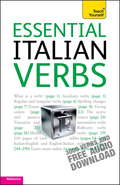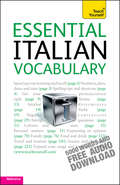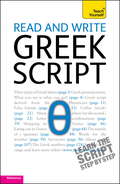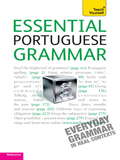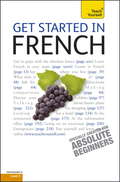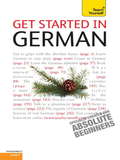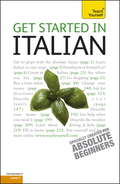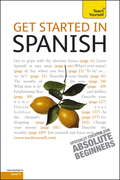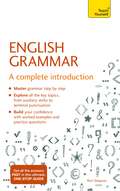- Table View
- List View
Essential French Vocabulary: Teach Yourself
by Noel Saint-ThomasEssential French Vocabulary is the course for you if you need help with your study of French. This fully revised edition of our best-selling course now comes with free downloadable audio support containing hints on how to learn vocabulary effectively.Unlike a phrasebook or a dictionary, Essential French Vocabulary will take your existing knowledge and build on it systematically and organically, so that you will increase your vocabulary and at the same time expand your range of expression.At the beginning of the book there is a section to help you with your pronunciation, followed by a short and simple grammar summary.The main part of the book is arranged in topics, such as 'Work', 'Travel and Accommodation' and 'Food and Drink', and concentrates on the vital and most current words and expressions, listing those which you might already know and then extending the coverage to teach you those you probably do not know.Finally, the downloadable audio recording will give you hints on how to increase your vocabulary effortlessly.This is an ideal companion if you are a language student or if you are wanting a systematic, easy-to-use tool to increase the range of your vocabulary and improve your ability to express yourself in a wide variety of situations, either on holiday or on a business trip. Learn effortlessly with a new, easy-to-read page design and interactive features:NOT GOT MUCH TIME?One, five and ten-minute introductions to key principles to get you started.AUTHOR INSIGHTSLots of instant help with common problems and quick tips for success, based on the author's many years of experience.END-OF-UNIT SUMMARIES AND ONLINE TESTSSummaries and tests to help you consolidate and keep track of your progress.EXTEND YOUR KNOWLEDGEExtra online articles at: www.teachyourself.com to give you a richer understanding of the culture and history of France.
Essential French Vocabulary: Teach Yourself
by Noel Saint-ThomasEssential French Vocabulary is the course for you if you need help with your study of French. This fully revised edition of our best-selling course now comes with free downloadable audio support containing hints on how to learn vocabulary effectively.Unlike a phrasebook or a dictionary, Essential French Vocabulary will take your existing knowledge and build on it systematically and organically, so that you will increase your vocabulary and at the same time expand your range of expression.At the beginning of the book there is a section to help you with your pronunciation, followed by a short and simple grammar summary.The main part of the book is arranged in topics, such as 'Work', 'Travel and Accommodation' and 'Food and Drink', and concentrates on the vital and most current words and expressions, listing those which you might already know and then extending the coverage to teach you those you probably do not know.Finally, the downloadable audio recording will give you hints on how to increase your vocabulary effortlessly.This is an ideal companion if you are a language student or if you are wanting a systematic, easy-to-use tool to increase the range of your vocabulary and improve your ability to express yourself in a wide variety of situations, either on holiday or on a business trip. Learn effortlessly with a new, easy-to-read page design and interactive features:NOT GOT MUCH TIME?One, five and ten-minute introductions to key principles to get you started.AUTHOR INSIGHTSLots of instant help with common problems and quick tips for success, based on the author's many years of experience.END-OF-UNIT SUMMARIES AND ONLINE TESTSSummaries and tests to help you consolidate and keep track of your progress.EXTEND YOUR KNOWLEDGEExtra online articles at: www.teachyourself.com to give you a richer understanding of the culture and history of France.
Essential German Grammar: Teach Yourself
by Jenny RussIs this the right book for me?Want to get more out of your study of German?Essential German Grammar is an up-to-date introduction to German grammar. You don't need to know a lot about grammar before you start. Everything is explained simply and there are lots of examples to illustrate each point. Unlike more traditional grammars, Essential German Grammar is structured so that you can look up language forms according to what you want to say, even if you don't know the grammatical term for them. If you already know some grammar, then you can use the 'reference grammar' section at the back of the book to look up the points you need.The course consists of 21 units illustrating the various uses to which the language can be put, for example, giving instructions or talking about the recent past. The more traditional reference grammar deals with grammatical structures, such as the imperative or the perfect tense. All grammatical terms are explained in the glossary at the back of the book. Each unit contains exercises for you to practise what you have learnt and there is a key at the back of the book for you to check your answers. The new page design in this edition means that the book is even easier to use and the main headings are in English so that you can find your way around the book quickly. This edition contains a 'taking it further' section which will direct you to further sources of real German. Essential German Grammar will help you to understand and manipulate German grammar with confidence because:- you need no prior knowledge of grammatical terminology to use it;- the approach is accessible and supportive;- the examples are clear and in context;- exercises help you practise every point.Now in a brand new edition with new, easy-to-follow page design and interactive online features.Learn effortlessly with a new easy-to-read page design and interactive features: Not got much time?One, five and ten-minute introductions to key principles to get you started.Author insightsLots of instant help with common problems and quick tips for success, based on the author's many years of experience.Test yourselfTests in the book and online to keep track of your progress.Extend your knowledgeExtra online articles to give you a richer understanding of the subject.Five things to rememberQuick refreshers to help you remember the key facts.Try thisInnovative exercises illustrate what you've learnt and how to use it.
Essential German Verbs: Teach Yourself
by Ian Roberts Silvia RobertsonIs this the right course for me?Essential German Verbs is the course for you if you need help with your study of German. This fully revised edition of our best-selling course now comes with free downloadable audio support containing hints on how to learn verbs effectively.The aim of this book is to help you improve your command of German by focusing on one aspect of language learning that invariably causes difficulties - verbs and the way they behave. Whether you are a complete beginner or a relatively advanced learner, you can consult the book when you need to know the form of a verb quickly. The introductory section gives you a complete overview of German verbs and how they work in the various tenses.Essential German Verbs contains:- full coverage of the main tenses for 200 frequently used German verbs arranged alphabetically for quick and easy reference- examples of the verbs in everyday use, with colloquial expressions and words sharing the same origin- a German-English verb list of approximately 3000 verbs with details of the patterns they follow- an English-German verb list giving the most frequently used English verbs in German with details of the patterns they follow- free downloadable audio support with hints on how to learn verbsLearn effortlessly with a new, easy-to-read page design and interactive features: Not got much time?One, five and ten-minute introductions to key principles to get you started.Author insightsLots of instant help with common problems and quick tips for success, based on the author's many years of experience.Useful vocabularyEasy to find and learn, to build a solid foundation for speaking.Online testsTests to help you keep track of your progress.Extend your knowledgeExtra online articles give you a richer understanding of the culture and history of Germany.
Essential German Verbs: Teach Yourself
by Ian Roberts Silvia RobertsonIs this the right course for me?Essential German Verbs is the course for you if you need help with your study of German. This fully revised edition of our best-selling course now comes with free downloadable audio support containing hints on how to learn verbs effectively.The aim of this book is to help you improve your command of German by focusing on one aspect of language learning that invariably causes difficulties - verbs and the way they behave. Whether you are a complete beginner or a relatively advanced learner, you can consult the book when you need to know the form of a verb quickly. The introductory section gives you a complete overview of German verbs and how they work in the various tenses.Essential German Verbs contains:- full coverage of the main tenses for 200 frequently used German verbs arranged alphabetically for quick and easy reference- examples of the verbs in everyday use, with colloquial expressions and words sharing the same origin- a German-English verb list of approximately 3000 verbs with details of the patterns they follow- an English-German verb list giving the most frequently used English verbs in German with details of the patterns they follow- free downloadable audio support with hints on how to learn verbsLearn effortlessly with a new, easy-to-read page design and interactive features: Not got much time?One, five and ten-minute introductions to key principles to get you started.Author insightsLots of instant help with common problems and quick tips for success, based on the author's many years of experience.Useful vocabularyEasy to find and learn, to build a solid foundation for speaking.Online testsTests to help you keep track of your progress.Extend your knowledgeExtra online articles give you a richer understanding of the culture and history of Germany.
Essential German Vocabulary: Teach Yourself
by Lisa KahlenIs this the right course for me?Essential German Vocabulary is the course for you if you need help with your study of German. This fully revised edition of our best-selling course now comes with free downloadable audio support containing hints on how to learn vocabulary effectively.Unlike a phrasebook or a dictionary, Essential German Vocabulary will take your existing knowledge and build on it systematically and organically, so that you will increase your vocabulary and at the same time expand your range of expression.At the beginning of the book there is a section to help you with your pronunciation, followed by a short and simple grammar summary.The main part of the book is arranged in topics, such as 'Work', 'Travel and Accommodation' and 'Food and Drink', and concentrates on the vital and most current words and expressions, listing those which you might already know and then extending the coverage to teach you those you probably do not know.Finally, the downloadable audio recording will give you hints on how to increase your vocabulary effortlessly.This is an ideal companion if you are a language student or if you are wanting a systematic, easy-to-use tool to increase the range of your vocabulary and improve your ability to express yourself in a wide variety of situations, either on holiday or on a business trip. Learn effortlessly with a new, easy-to-read page design and interactive features: Not got much time?One, five and ten-minute introductions to key principles to get you started.Author insightsLots of instant help with common problems and quick tips for success, based on the author's many years of experience.End-of-unit summaries and online testsSummaries and tests to help you consolidate and keep track of your progress.Extend your knowledgeExtra online articles to give you a richer understanding of the culture and history of Germany.
Essential Spanish Grammar: Teach Yourself
by Juan Kattan-IbarraIs this the right course for me?Essential Spanish Grammar will help you get more out of your study of Spanish. Essential Spanish Grammar is an up-to-date introduction to Spanish grammar. You don't need to know a lot about grammar before you start. Everything is explained simply and there are lots of examples to illustrate each point. Unlike more traditional grammars, Essential Spanish Grammar is structured so that you can look up language forms according to what you want to say, even if you don't know the grammatical term for them. If you already know some grammar, then you can use the 'reference grammar' section at the back of the book to look up the points you need.The course consists of 23 units illustrating the various uses to which the language can be put, for example, giving instructions or talking about the recent past. The more traditional reference grammar deals with grammatical structures, such as the imperative or the perfect tense. All grammatical terms are explained in the glossary at the back of the book. Each unit contains exercises for you to practise what you have learnt and there is a key at the back of the book for you to check your answers. The new page design in this edition means that the book is even easier to use and the main headings are in English so that you can find your way around the book quickly. This edition contains a 'taking it further' section which will direct you to further sources of real Spanish. Essential Spanish Grammar will help you to understand and manipulate Spanish grammar with confidence because:- you need no prior knowledge of grammatical terminology to use it;- the approach is accessible and supportive;- the examples are clear and in context;- exercises help you practise every point.Learn effortlessly with a new, easy-to-follow page design and interactive features:Not got much time?One, five and ten-minute introductions to key principles to get you started.Author insightsLots of instant help with common problems and quick tips for success, based on the author's many years of experience.Useful vocabularyEasy to find and learn, to build a solid foundation for speaking.End-of-unit summaries and online testsSummaries and tests to help you keep track of your progress.Extend your knowledgeExtra online articles to give you a richer understanding of the culture and history of Spain.
Essential Spanish Verbs: Teach Yourself
by Maria Rosario HollisEssential Spanish Verbs is the course for you if you need help with your study of Spanish. This fully revised edition of our best-selling course now comes with free downloadable audio support containing hints on how to learn verbs effectively. The aim of this book is to help you improve your command of Spanish by focusing on one aspect of language learning that invariably causes difficulties - verbs and the way they behave. Whether you are a complete beginner or a relatively advanced learner, you can consult the book when you need to know the form of a verb quickly. The introductory section gives you a complete overview of Spanish verbs and how they work in the various tenses. Essential Spanish Verbs contains: - full coverage of the main tenses for 200 frequently used Spanish verbs arranged alphabetically for quick and easy reference - examples of the verbs in everyday use, with colloquial expressions and words sharing the same origin - a Spanish-English verb list of approximately 3000 verbs with details of the patterns they follow - an English- Spanish verb list giving the most frequently used English verbs in Spanish with details of the patterns they follow - free downloadable audio support with hints on how to learn verbs Learn effortlessly with a new, easy-to-read page design and interactive features: NOT GOT MUCH TIME? One, five and ten-minute introductions to key principles to get you started. AUTHOR INSIGHTS Lots of instant help with common problems and quick tips for success, based on the author's many years of experience. USEFUL VOCABULARY Easy to find and learn, to build a solid foundation for speaking. ONLINE TESTS Tests to help you keep track of your progress. Download our free app, Teach Yourself Library, from the App Store or Google Play to access the free audio.
Essential Spanish Vocabulary: Teach Yourself
by Mike ZolloEssential Spanish Vocabulary is the course for you if you need help with your study of Spanish. This fully revised edition of our best-selling course now comes with free downloadable audio support containing hints on how to learn vocabulary effectively.Unlike a phrasebook or a dictionary, Essential Spanish Vocabulary will take your existing knowledge and build on it systematically and organically, so that you will increase your vocabulary and at the same time expand your range of expression.At the beginning of the book there is a section to help you with your pronunciation, followed by a short and simple grammar summary.The main part of the book is arranged in topics, such as 'Work', 'Travel and Accommodation' and 'Food and Drink', and concentrates on the vital and most current words and expressions, listing those which you might already know and then extending the coverage to teach you those you probably do not know.Finally, the downloadable audio recording will give you hints on how to increase your vocabulary effortlessly.This is an ideal companion if you are a language student or if you are wanting a systematic, easy-to-use tool to increase the range of your vocabulary and improve your ability to express yourself in a wide variety of situations, either on holiday or on a business trip. Learn effortlessly with a new, easy-to-read page design and interactive features: NOT GOT MUCH TIME?One, five and ten-minute introductions to key principles to get you started.AUTHOR INSIGHTSLots of instant help with common problems and quick tips for success, based on the author's many years of experience.END-OF-UNIT SUMMARIES AND ONLINE TESTSSummaries and tests to help you consolidate and keep track of your progress.EXTEND YOUR KNOWLEDGEExtra online articles at: www.teachyourself.com to give you a richer understanding of the culture and history of Spain.
Essential Spanish Vocabulary: Teach Yourself
by Mike ZolloEssential Spanish Vocabulary is the course for you if you need help with your study of Spanish. This fully revised edition of our best-selling course now comes with free downloadable audio support containing hints on how to learn vocabulary effectively.Unlike a phrasebook or a dictionary, Essential Spanish Vocabulary will take your existing knowledge and build on it systematically and organically, so that you will increase your vocabulary and at the same time expand your range of expression.At the beginning of the book there is a section to help you with your pronunciation, followed by a short and simple grammar summary.The main part of the book is arranged in topics, such as 'Work', 'Travel and Accommodation' and 'Food and Drink', and concentrates on the vital and most current words and expressions, listing those which you might already know and then extending the coverage to teach you those you probably do not know.Finally, the downloadable audio recording will give you hints on how to increase your vocabulary effortlessly.This is an ideal companion if you are a language student or if you are wanting a systematic, easy-to-use tool to increase the range of your vocabulary and improve your ability to express yourself in a wide variety of situations, either on holiday or on a business trip. Learn effortlessly with a new, easy-to-read page design and interactive features: NOT GOT MUCH TIME?One, five and ten-minute introductions to key principles to get you started.AUTHOR INSIGHTSLots of instant help with common problems and quick tips for success, based on the author's many years of experience.END-OF-UNIT SUMMARIES AND ONLINE TESTSSummaries and tests to help you consolidate and keep track of your progress.EXTEND YOUR KNOWLEDGEExtra online articles at: www.teachyourself.com to give you a richer understanding of the culture and history of Spain.
Essential Italian Verbs: Teach Yourself
by Maria BonacinaIs this the right course for me?Essential Italian Verbs is the course for you if you need help with your study of Italian. This fully revised edition of our best-selling course now comes with free downloadable audio support containing hints on how to learn verbs effectively.The aim of this book is to help you improve your command of Italian by focusing on one aspect of language learning that invariably causes difficulties - verbs and the way they behave. Whether you are a complete beginner or a relatively advanced learner, you can consult the book when you need to know the form of a verb quickly. The introductory section gives you a complete overview of Italian verbs and how they work in the various tenses. This book also contains:- full coverage of the main tenses for 200 frequently used Italian verbs arranged alphabetically for quick and easy reference- examples of the verbs in everyday use, with colloquial expressions and words sharing the same origin- an Italian-English verb list of approximately 3000 verbs with details of the patterns they follow- an English-Italian verb list giving the most frequently used English verbs in Italian with details of the patterns they follow- free downloadable audio support with hints on how to learn verbsEssential Italian includes:Chapter 1: What is a verb?Chapter 2: I, you, he, she, it...: personChapter 3: Past, present, future...: tenseChapter 4: Regular and irregular verbsChapter 5: Formation and use of tensesChapter 6: Indicative, conditional subjunctive, imperative...: moodChapter 7: The active and passive voicesChapter 8: Transitive and intransitive verbsChapter 9: Impersonal verbs and constructionsChapter 10: Impersonal verbs and constructionsChapter 11: The impersonal si and the passive siChapter 12: Model verbsChapter 13: Verbs not related to timeChapter 14: Verb-noun collocationsLearn effortlessly with a new, easy-to-read page design and interactive features:Not got much time?One, five and ten-minute introductions to key principles to get you started.Author insightsLots of instant help with common problems and quick tips for success, based on the author's many years of experience.Useful vocabularyEasy to find and learn, to build a solid foundation for speaking.Online testsTests to help you keep track of your progress.Extend your knowledgeExtra online articles to give you a richer understanding of the culture and history of Italy.
Essential Italian Verbs: Teach Yourself
by Maria BonacinaIs this the right course for me?Essential Italian Verbs is the course for you if you need help with your study of Italian. This fully revised edition of our best-selling course now comes with free downloadable audio support containing hints on how to learn verbs effectively.The aim of this book is to help you improve your command of Italian by focusing on one aspect of language learning that invariably causes difficulties - verbs and the way they behave. Whether you are a complete beginner or a relatively advanced learner, you can consult the book when you need to know the form of a verb quickly. The introductory section gives you a complete overview of Italian verbs and how they work in the various tenses. This book also contains:- full coverage of the main tenses for 200 frequently used Italian verbs arranged alphabetically for quick and easy reference- examples of the verbs in everyday use, with colloquial expressions and words sharing the same origin- an Italian-English verb list of approximately 3000 verbs with details of the patterns they follow- an English-Italian verb list giving the most frequently used English verbs in Italian with details of the patterns they follow- free downloadable audio support with hints on how to learn verbsEssential Italian includes:Chapter 1: What is a verb?Chapter 2: I, you, he, she, it...: personChapter 3: Past, present, future...: tenseChapter 4: Regular and irregular verbsChapter 5: Formation and use of tensesChapter 6: Indicative, conditional subjunctive, imperative...: moodChapter 7: The active and passive voicesChapter 8: Transitive and intransitive verbsChapter 9: Impersonal verbs and constructionsChapter 10: Impersonal verbs and constructionsChapter 11: The impersonal si and the passive siChapter 12: Model verbsChapter 13: Verbs not related to timeChapter 14: Verb-noun collocationsLearn effortlessly with a new, easy-to-read page design and interactive features:Not got much time?One, five and ten-minute introductions to key principles to get you started.Author insightsLots of instant help with common problems and quick tips for success, based on the author's many years of experience.Useful vocabularyEasy to find and learn, to build a solid foundation for speaking.Online testsTests to help you keep track of your progress.Extend your knowledgeExtra online articles to give you a richer understanding of the culture and history of Italy.
Essential Italian Vocabulary: Teach Yourself
by Mike ZolloEssential Italian Vocabulary is the course for you if you need help with your study of Italian. This fully revised edition of our best-selling course now comes with free downloadable audio support containing hints on how to learn vocabulary effectively. Unlike a phrasebook or a dictionary, Essential Italian Vocabulary will take your existing knowledge and build on it systematically and organically, so that you will increase your vocabulary and at the same time expand your range of expression.
Essential Italian Vocabulary: Teach Yourself
by Mike ZolloEssential Italian Vocabulary is the course for you if you need help with your study of Italian. This fully revised edition of our best-selling course now comes with free downloadable audio support containing hints on how to learn vocabulary effectively. Unlike a phrasebook or a dictionary, Essential Italian Vocabulary will take your existing knowledge and build on it systematically and organically, so that you will increase your vocabulary and at the same time expand your range of expression.
Read and write Greek script: Teach Yourself
by Sheila Hunt Dennis CouniacisMaster Greek script with this straightforward guide from Teach Yourself - the No. 1 brand in language learning. Read and write Greek script is a clear step-by-step guide to the written language, with plenty of examples from real-life texts to show how it works in context and lots of exercises to reinforce your learning. This new edition has an easy-to-read page design.Now fully updated to make your language learning experience fun and interactive. You can still rely on the benefits of a top language teacher and our years of teaching experience, but now with added learning features within the course and online. Learn effortlessly with new, easy-to-read page design and interactive features: NOT GOT MUCH TIME?One, five and ten-minute introductions to key principles to get you started.AUTHOR INSIGHTSLots of instant help with common problems and quick tips for success, based on the author's many years of experience.USEFUL VOCABULARYEasy to find and learn, to build a solid foundation for speaking.TEST YOURSELFTests in the book and online to keep track of your progress.EXTEND YOUR KNOWLEDGEExtra online articles at: www.teachyourself.com to give you a richer understanding of the culture and history of Greece.TRY THISInnovative exercises illustrate what you've learnt and how to use it.
Essential Portuguese Grammar: Teach Yourself
by Sue Tyson-WardEssential Portuguese Grammar will help you get more out of your study of Portuguese. Essential Portuguese Grammar is an up-to-date introduction to Portuguese grammar. You don't need to know a lot about grammar before you start. Everything is explained simply and there are lots of examples to illustrate each point. Unlike more traditional grammars, Essential Portuguese Grammar is structured so that you can look up language forms according to what you want to say, even if you don't know the grammatical term for them. If you already know some grammar, then you can use the 'reference grammar' section at the back of the book to look up the points you need.The course consists of 46 units illustrating the various uses to which the language can be put, for example, giving instructions or talking about the recent past. The more traditional reference grammar deals with grammatical structures, such as the imperative or the perfect tense. All grammatical terms are explained in the glossary at the back of the book. Each unit contains exercises for you to practise what you have learnt and there is a key at the back of the book for you to check your answers. The new page design in this edition means that the book is even easier to use and the main headings are in English so that you can find your way around the book quickly. This edition contains a 'taking it further' section which will direct you to further sources of real Portuguese. Essential Portuguese Grammar will help you to understand and manipulate Portuguese grammar with confidence because:- you need no prior knowledge of grammatical terminology to use it;- the approach is accessible and supportive;- the examples are clear and in context;- exercises help you practise every point.Now in a brand new edition with new, easy-to-follow page design:
Essential Portuguese Grammar: Teach Yourself
by Sue Tyson-WardEssential Portuguese Grammar will help you get more out of your study of Portuguese. Essential Portuguese Grammar is an up-to-date introduction to Portuguese grammar. You don't need to know a lot about grammar before you start. Everything is explained simply and there are lots of examples to illustrate each point. Unlike more traditional grammars, Essential Portuguese Grammar is structured so that you can look up language forms according to what you want to say, even if you don't know the grammatical term for them. If you already know some grammar, then you can use the 'reference grammar' section at the back of the book to look up the points you need.The course consists of 46 units illustrating the various uses to which the language can be put, for example, giving instructions or talking about the recent past. The more traditional reference grammar deals with grammatical structures, such as the imperative or the perfect tense. All grammatical terms are explained in the glossary at the back of the book. Each unit contains exercises for you to practise what you have learnt and there is a key at the back of the book for you to check your answers. The new page design in this edition means that the book is even easier to use and the main headings are in English so that you can find your way around the book quickly. This edition contains a 'taking it further' section which will direct you to further sources of real Portuguese. Essential Portuguese Grammar will help you to understand and manipulate Portuguese grammar with confidence because:- you need no prior knowledge of grammatical terminology to use it;- the approach is accessible and supportive;- the examples are clear and in context;- exercises help you practise every point.Now in a brand new edition with new, easy-to-follow page design:
Get Started in Beginner's French: Teach Yourself
by Catrine CarpenterAre you looking for a course in French written for the absolute beginner who has no experience of learning a foreign language? Get Started in French will give you the confidence to communicate in French. Now fully updated to make your language learning experience fun and interactive. You can still rely on the benefits of a top language teacher and our years of teaching experience, but now with added learning features within the course and online. The emphasis of the course is placed on communication, rather than grammar, and all the teaching is in English, so that you will quickly and effortlessly get started in French. By the end of this course, you will be at Level B1 of the Common European Framework for Languages: Can deal with most situations likely to arise whilst travelling in an area where the language is spoken. Learn effortlessly with new, full-colour easy-to-read page design and interactive features: NOT GOT MUCH TIME?One, five and ten-minute introductions to key principles to get you started.AUTHOR INSIGHTSLots of instant help with common problems and quick tips for success, based on the author's many years of experience.USEFUL VOCABULARYEasy to find and learn, to build a solid foundation for speaking.DIALOGUESRead and listen to everyday dialogues to help you speak and understand fast.PRONUNCIATIONDon't sound like a tourist! Perfect your pronunciation before you go.TEST YOURSELFTests in the book and online to keep track of your progress.EXTEND YOUR KNOWLEDGEExtra online articles at: www.teachyourself.com to give you a richer understanding of the culture and history of France.TRY THISInnovative exercises illustrate what you've learnt and how to use it.The course is available as a book (9781444100709), as a pack comprising the book and double CD (9781444100716) and as a double CD (9781444100723).
Get Started in Beginner's French: Teach Yourself
by Catrine CarpenterAre you looking for a course in French written for the absolute beginner who has no experience of learning a foreign language? Get Started in French will give you the confidence to communicate in French. Now fully updated to make your language learning experience fun and interactive. You can still rely on the benefits of a top language teacher and our years of teaching experience, but now with added learning features within the course and online. The emphasis of the course is placed on communication, rather than grammar, and all the teaching is in English, so that you will quickly and effortlessly get started in French. By the end of this course, you will be at Level B1 of the Common European Framework for Languages: Can deal with most situations likely to arise whilst travelling in an area where the language is spoken. Learn effortlessly with new, full-colour easy-to-read page design and interactive features: NOT GOT MUCH TIME?One, five and ten-minute introductions to key principles to get you started.AUTHOR INSIGHTSLots of instant help with common problems and quick tips for success, based on the author's many years of experience.USEFUL VOCABULARYEasy to find and learn, to build a solid foundation for speaking.DIALOGUESRead and listen to everyday dialogues to help you speak and understand fast.PRONUNCIATIONDon't sound like a tourist! Perfect your pronunciation before you go.TEST YOURSELFTests in the book and online to keep track of your progress.EXTEND YOUR KNOWLEDGEExtra online articles at: www.teachyourself.com to give you a richer understanding of the culture and history of France.TRY THISInnovative exercises illustrate what you've learnt and how to use it.The course is available as a book (9781444100709), as a pack comprising the book and double CD (9781444100716) and as a double CD (9781444100723).
Get Started in Beginner's German: Teach Yourself
by Rosi McNabAre you looking for a course in German written for the absolute beginner who has no experience of learning a foreign language? Get Started in German will give you the confidence to communicate in German. Now fully updated to make your language learning experience fun and interactive. You can still rely on the benefits of a top language teacher and our years of teaching experience, but now with added learning features within the course and online. The emphasis of the course is placed on communication, rather than grammar, and all the teaching is in English, so that you will quickly and effortlessly get started in German. By the end of this course, you will be at Level B1 of the Common European Framework for Languages: Can deal with most situations likely to arise whilst travelling in an area where the language is spoken. Learn effortlessly with new, easy-to-read page design and interactive features: NOT GOT MUCH TIME?One and ten-minute introductions to key principles to get you started.AUTHOR INSIGHTSLots of instant help with common problems and quick tips for success, based on the author's many years of experience.USEFUL VOCABULARYEasy to find and learn, to build a solid foundation for speaking.DIALOGUESRead and listen to everyday dialogues to help you speak and understand fast.PRONUNCIATIONDon't sound like a tourist! Perfect your pronunciation before you go.TEST YOURSELFTests in the book and online to keep track of your progress.EXTEND YOUR KNOWLEDGEExtra online articles to give you a richer understanding of the culture and history of Germany.TRY THISInnovative exercises illustrate what you've learnt and how to use it.
Get Started in Beginner's German: Teach Yourself
by Rosi McNabAre you looking for a course in German written for the absolute beginner who has no experience of learning a foreign language? Get Started in German will give you the confidence to communicate in German. Now fully updated to make your language learning experience fun and interactive. You can still rely on the benefits of a top language teacher and our years of teaching experience, but now with added learning features within the course and online. The emphasis of the course is placed on communication, rather than grammar, and all the teaching is in English, so that you will quickly and effortlessly get started in German. By the end of this course, you will be at Level B1 of the Common European Framework for Languages: Can deal with most situations likely to arise whilst travelling in an area where the language is spoken. Learn effortlessly with new, easy-to-read page design and interactive features: NOT GOT MUCH TIME?One and ten-minute introductions to key principles to get you started.AUTHOR INSIGHTSLots of instant help with common problems and quick tips for success, based on the author's many years of experience.USEFUL VOCABULARYEasy to find and learn, to build a solid foundation for speaking.DIALOGUESRead and listen to everyday dialogues to help you speak and understand fast.PRONUNCIATIONDon't sound like a tourist! Perfect your pronunciation before you go.TEST YOURSELFTests in the book and online to keep track of your progress.EXTEND YOUR KNOWLEDGEExtra online articles to give you a richer understanding of the culture and history of Germany.TRY THISInnovative exercises illustrate what you've learnt and how to use it.
Get Started in Beginner's Italian: Teach Yourself
by Vittoria BowlesThis product is most effective when used in conjunction with the corresponding audio support.- You can purchase the book and audio support as a pack (ISBN: 9781444100778)- The audio support is also sold separately (ISBN: 9781444100785)(copy and paste the ISBN number into the search bar to find these products)Are you looking for a course in Italian written for the absolute beginner who has no experience of learning a foreign language? Get Started in Italian will give you the confidence to communicate in Italian.Now fully updated to make your language learning experience fun and interactive. You can still rely on the benefits of a top language teacher and our years of teaching experience, but now with added learning features within the course and online.The emphasis of the course is placed on communication, rather than grammar, and all the teaching is in English, so that you will quickly and effortlessly get started in Italian.By the end of this course, you will be at Level B1 of the Common European Framework for Languages: Can deal with most situations likely to arise whilst travelling in an area where the language is spoken.Learn effortlessly with new, easy-to-read page design and interactive features:NOT GOT MUCH TIME?One, five and ten-minute introductions to key principles to get you started.AUTHOR INSIGHTSLots of instant help with common problems and quick tips for success, based on the author's many years of experience.USEFUL VOCABULARYEasy to find and learn, to build a solid foundation for speaking.DIALOGUESRead and listen to everyday dialogues to help you speak and understand fast.PRONUNCIATIONDon't sound like a tourist! Perfect your pronunciation before you go.TEST YOURSELFTests in the book and online to keep track of your progress.EXTEND YOUR KNOWLEDGEExtra online articles at: www.teachyourself.com to give you a richer understanding of the culture and history of Italy.TRY THISInnovative exercises illustrate what you've learnt and how to use it.
Get Started in Beginner's Italian: Teach Yourself
by Vittoria BowlesThis product is most effective when used in conjunction with the corresponding audio support.- You can purchase the book and audio support as a pack (ISBN: 9781444100778)- The audio support is also sold separately (ISBN: 9781444100785)(copy and paste the ISBN number into the search bar to find these products)Are you looking for a course in Italian written for the absolute beginner who has no experience of learning a foreign language? Get Started in Italian will give you the confidence to communicate in Italian.Now fully updated to make your language learning experience fun and interactive. You can still rely on the benefits of a top language teacher and our years of teaching experience, but now with added learning features within the course and online.The emphasis of the course is placed on communication, rather than grammar, and all the teaching is in English, so that you will quickly and effortlessly get started in Italian.By the end of this course, you will be at Level B1 of the Common European Framework for Languages: Can deal with most situations likely to arise whilst travelling in an area where the language is spoken.Learn effortlessly with new, easy-to-read page design and interactive features:NOT GOT MUCH TIME?One, five and ten-minute introductions to key principles to get you started.AUTHOR INSIGHTSLots of instant help with common problems and quick tips for success, based on the author's many years of experience.USEFUL VOCABULARYEasy to find and learn, to build a solid foundation for speaking.DIALOGUESRead and listen to everyday dialogues to help you speak and understand fast.PRONUNCIATIONDon't sound like a tourist! Perfect your pronunciation before you go.TEST YOURSELFTests in the book and online to keep track of your progress.EXTEND YOUR KNOWLEDGEExtra online articles at: www.teachyourself.com to give you a richer understanding of the culture and history of Italy.TRY THISInnovative exercises illustrate what you've learnt and how to use it.
Get Started in Beginner's Spanish: Teach Yourself
by Mark Stacey Angela Gonzalez HeviaAre you looking for a course in Spanish written for the absolute beginner who has no experience of learning a foreign language? Get Started in Spanish will give you the confidence to communicate in Spanish. Now fully updated to make your language learning experience fun and interactive. You can still rely on the benefits of a top language teacher and our years of teaching experience, but now with added learning features within the course and online. The emphasis of the course is placed on communication, rather than grammar, and all the teaching is in English, so that you will quickly and effortlessly get started in Spanish. By the end of this course, you will be at Level B1 of the Common European Framework for Languages: Can deal with most situations likely to arise whilst travelling in an area where the language is spoken. Learn effortlessly with new, full-colour easy-to-read page design and interactive features: NOT GOT MUCH TIME?One, five and ten-minute introductions to key principles to get you started.AUTHOR INSIGHTSLots of instant help with common problems and quick tips for success, based on the author's many years of experience.USEFUL VOCABULARYEasy to find and learn, to build a solid foundation for speaking.DIALOGUESRead and listen to everyday dialogues to help you speak and understand fast.PRONUNCIATIONDon't sound like a tourist! Perfect your pronunciation before you go.TEST YOURSELFTests in the book and online to keep track of your progress.EXTEND YOUR KNOWLEDGEExtra online articles at: www.teachyourself.com to give you a richer understanding of the culture and history of Spain.TRY THISInnovative exercises illustrate what you've learnt and how to use it.
Essential English Grammar: A Complete Introduction (TY English Reference)
by Ron Simpson Brigitte EdelstonEssential English Grammar is packed with easy-to-follow explanations and summaries, practical tips on how to avoid common grammar mistakes, interesting facts about the historical and regional use of English and a special section on punctuation. This clear, straightforward guide to modern English grammar will help you to improve your knowledge of the language and perfect your grammar.NOT GOT MUCH TIME?One, five and ten-minute introductions to key principles to get you started.AUTHOR INSIGHTSLots of instant help with common problems and quick tips for success, based on the author's many years of experience.TEST YOURSELFTests in the book and online to keep track of your progress.EXTEND YOUR KNOWLEDGEExtra online articles at www.teachyourself.com to give you a richer understanding of English grammar.FIVE THINGS TO REMEMBERQuick refreshers to help you remember the key facts.TRY THISInnovative exercises illustrate what you've learnt and how to use it.
